A New Hybrid Intelligent System for Predicting Bottom-Hole Pressure in Vertical Oil Wells: A Case Study
Abstract
1. Introduction
2. Methods
2.1. Adaptive Neuro-Fuzzy Inference System
- Layer 1: Fuzzification
- Layer 2: Rule Evaluation
- Layer 3: Normalization
- Layer 4: Consequent Computation
- Layer 5: Aggregation
- Learning Algorithms
- -
- Gradient Descent Only: All parameters—both antecedent and consequent—are updated simultaneously using gradient descent.
- -
- One-Time LSE + Gradient Descent: Initial values are assigned to the parameters, and then the least squares estimator (LSE) is used once for optimizing the consequent parameters, after which all parameters are updated via gradient descent.
- -
- Hybrid Learning (LSE + Gradient Descent): This widely used approach combines forward-pass LSE for consequent parameters with backward-pass gradient descent for antecedent membership function parameters. It offers fast convergence and balanced complexity.
- -
- Extended Kalman Filter (EKF): All parameters are updated using a recursive EKF approach, which generally yields high accuracy at the cost of increased computational load.
- Performance evaluation
2.2. Particle Swarm Optimization PSO Algorithm
- -
- Simplicity of implementation: PSO is conceptually straightforward and easy to code.
- -
- Minimal parameter tuning: It requires fewer parameters to be adjusted compared to other metaheuristic algorithms.
- -
- Fast convergence: PSO typically converges quickly toward optimal or near-optimal solutions [29].
- -
- Low computational overhead: It demands significantly less computational effort than many other population-based techniques [30].
- -
- High precision: It can achieve accurate results across a range of problem types.
- -
- Robustness to dimensionality: The algorithm’s performance is not severely degraded by an increase in the number of variables.
- ➢
- Individual Best (Pbest): Based just on its own historical best position, each particle modifies its velocity.
- ➢
- Global Best (Gbest): Each particle is influenced by the optimal location found by every swarm particle.
- ➢
- Hybrid Strategy: A combination of both individual and global knowledge, allowing a balance between investigating new areas and taking advantage of established, promising ones.
- Step 1: Randomly initialize each particle Pi ∈ P(t) position Xi(t) within the search space, with t = 0.
- Step 2: Use the current position Xi(t) to calculate the fitness F for each particle.
- Step 3: For each particle update the personal best by comparing the current fitness with its previously recorded best:
- Step 4: Evaluate each individual best fitness against the global best:
- Step 5: Update the velocity vector for each particle:
- Step 6: Update each particle position:
- Step 7: Repeat from Step 2 until convergence is achieved.
- Parameter selection:
- Fixed-parameter PSO—parameter values are either determined by trial and error or as generally accepted values from the literature.
- Dynamic or adaptive parameters PSO.
- Composite PSO. Although it has not been utilized much in the PSO literature, a heuristic technique is employed to determine the ideal PSO parameters. The main issue with this approach is that it makes the problem much more complex.
- Parameter-free PSO—eliminates the need for a parameter-setting procedure.
3. Methodology
3.1. Data Acquisition
3.2. Data Pre-Processing and Filtration
- Use various flow correlations to calculate the bottom hole pressure BHP by feeding well test data sets into the PIPESIM software 2020 platform.
- Calculate the AAPRE% for each correlation.
- For each data set and for all correlations, the arithmetic average of AAPRE% was computed.
- Data sets for which AAPRE% is more than 20% were removed.
3.3. ANFIS Model Development
3.4. Optimizing ANFIS by PSO Algorithm
- ➢
- First, the antecedent parameters are placed at the beginning of the chromosome.
- ➢
- The membership function parameters of each input variable are placed in the first two genes, followed by the next two genes for the second membership function, and so on.
- ➢
- This sequence continues input-by-input until all antecedent parameters have been encoded.
- ➢
- Next, the consequent parameters (i.e., the linear coefficients of the Sugeno-type rules) are appended to the same chromosome, following the antecedent parameters.
4. Results and Discussion
- ▪
- Cross plot (Figure 4 and Figure 5): These figures display the BHP obtained with the advanced model as opposed to experimental data. Figure 4 shows the alignment of the plotted data to the 45° straight line which is logical because the training sets of data have been firstly used for developing the ANFIS, so with a coefficient of correlation R2 of 0.997 for this set of training data, we can prove the good fitting of the data by the ANFIS. Figure 5 displays the quality of the developed model in calculating BHP with testing data. By plotting the ANFIS model results obtained for the testing data set against the actual data, and with a coefficient of correlation R2 of 0.997, we can demonstrate the accuracy of the ANFIS.
- ▪
- Plots of predicted vs. measured BHP (Figure 6 and Figure 7) for training and testing samples: These plots help in easily identifying the deviation of the model in predicting the BHP. Figure 6 and Figure 7 show that the ANFIS model can accurately predict the BHP for both the training and testing data sets.
4.1. Comparison of the ANFIS Model Against Correlations
4.2. Comparison of the Particle Swarm Optimization (PSO) Against the Back Propagation (BP) for ANFIS Training
5. Conclusions
- ➢
- Even though the system has proven effective for vertical wells with multiphase flow, it would be interesting to test the solution application to other assets such as horizontal wells, multilateral wells, and injection wells.
- ➢
- Additional heuristic and gradient-based search algorithms should be explored to enhance the efficiency of training and updating ANFIS parameters.
- ➢
- In order to enable more reliable improvement for the developed model, a larger and diverse training data set should be gathered to cover more scenarios beyond the ranges of data used in this work.
Author Contributions
Funding
Data Availability Statement
Acknowledgments
Conflicts of Interest
Nomenclature
| BHP | Bottom-hole pressure |
| AAPRD | Average absolute percentage relative deviation |
| FIS | Fuzzy Inference System |
| GOR | Gas–oil ratio |
| SD | Standard deviation |
| PSO | Particle Swarm Optimization |
| BP | Back Propagation |
| RMSE | Root Mean Square Error |
References
- Ternyik, J.; Bilgesu, H.I.; Mohaghegh, S. Virtual Measurements in Pipes: Part 1-Flowing Bottom Hole Pressure Under Multi-Phase Flow and Inclined Wellbore Conditions; SPE: Bellingham, WA, USA, 1995; p. SPE-30975. [Google Scholar]
- Takacs, G. Considerations on the Selection of an Optimum Vertical Multiphase Pressure Drop Prediction Model for Oil Wells; SPE: Tulsa, OK, USA, 2001; p. SPE-68361. [Google Scholar]
- Al-Shammari, A. Accurate Prediction of Pressure Drop in Two-Phase Vertical Flow Systems Using Artificial Intelligence; SPE: Al-Khobar, Saudi Arabia, 2011; p. SPE-149035. [Google Scholar]
- Osman, E.A.; Ayoub, M.A.; Aggour, M.A. Artificial Neural Network Model for Predicting Bottomhole Flowing Pressure in Vertical Multiphase Flow; SPE: Awali, Bahrain, 2005; p. SPE-93632. [Google Scholar]
- Barrufet, M.A.; Rasool, A.; Aggour, M.A. Prediction of Bottomhole Flowing Pressures in Multiphase Systems Using a Thermodynamic Equation of State; SPE: Tulsa, OK, USA, 1995. [Google Scholar]
- Mohammadpoor, M.; Shahbazi, K.H.; Torabi, F.; Qazvini, A. A New Methodology for Prediction of Bottomhole Flowing Pressure in Vertical Multiphase Flow in Iranian Oil fields Using Artificial Neural Networks (ANNs); SPE: Lima, Peru, 2010; p. SPE-139147. [Google Scholar]
- Wu, C.L.; Chau, K.W.; Li, Y.S. Methods to improve neural network performance in daily flows prediction. J. Hydrol. 2009, 372, 80–93. [Google Scholar] [CrossRef]
- Wang, W.C.; Chau, K.W.; Xu, D.M.; Chen, X.Y. Improving forecasting accuracy of annual runoff time series using ARIMA based on EEMD decomposition. Water Resour. Manag. 2015, 29, 2655–2675. [Google Scholar] [CrossRef]
- Zhang, S.W.; Chau, K.W. Dimension Reduction Using Semi-Supervised Locally Linear Embedding for Plant Leaf Classification. In Emerging Intelligent Computing Technology and Applications. ICIC 2009; Lecture Notes in Computer Science; Springer: Berlin/Heidelberg, Germany, 2009; Volume 5754, pp. 948–955. [Google Scholar]
- Chau, K.W.; Wu, C.L. A Hybrid Model Coupled with Singular Spectrum Analysis for Daily Rainfall Prediction. J. Hydroinform. 2010, 12, 458–473. [Google Scholar] [CrossRef]
- Zhu, Z.; Song, X.; Zhang, R.; Li, G.; Han, L.; Hu, X.; Li, D.; Yang, D.; Qin, F. A hybrid neural network model for predicting bottomhole pressure in managed pressure drilling. Appl. Sci. 2022, 12, 6728. [Google Scholar] [CrossRef]
- Agwu, O.E.; Alatefi, S.; Alkouh, A.; Suppiah, R.R. Modelling the flowing bottom hole pressure of oil and gas wells using multivariate adaptive regression splines. J. Pet. Explor. Prod. Technol. 2025, 15, 22. [Google Scholar] [CrossRef]
- Sun, H.; Luo, Q.; Xia, Z.; Li, Y.; Yu, Y. Bottomhole pressure prediction of carbonate reservoirs using XGBoost. Processes 2024, 12, 125. [Google Scholar] [CrossRef]
- Nwanwe, C.C.; Duru, U.I.; Anyadiegwu, C.; Ekejuba, A.I.B. An artificial neural network visible mathematical model for real-time prediction of multiphase flowing bottom-hole pressure in wellbores. Pet. Res. 2023, 8, 370–385. [Google Scholar] [CrossRef]
- Afagwu, C.C.; Glatz, G. Development of a hybrid modelling approach for estimating bottom hole pressure in shale and tight sand wells using smart production data and machine learning techniques. In Proceedings of the International Petroleum Technology Conference, Dhahran, Saudi Arabia, 12–14 February 2024. [Google Scholar] [CrossRef]
- Hagedorn, A.R.; Brown, K.E. Experimental Study of Pressure Gradients Occurring During Continuous Two-Phase Flow in Small-Diameter Vertical Conduits. J. Pet. Technol. 1965, 234, 475–484. [Google Scholar] [CrossRef]
- Duns, H.; Ros, N.C.J. Vertical Flow of Gas and Liquid Mixtures from Boreholes. In Proceedings of the 6th World Petroleum Congress, Frankfurt am Main, Germany, 19–26 June 1963. [Google Scholar]
- Orkiszwiski, J. Predicting Two-Phase Pressure Drops in Vertical Pipes; SPE: Bellingham, WA, USA, 1966; p. SPE-1546. [Google Scholar]
- Beggs, H.D.; Brill, J.P. A Study of Two-Phase Flow in Inclined Pipes. J. Pet. Technol. 1973, 255, 607–617. [Google Scholar] [CrossRef]
- Aziz, K.; Govier, G.W.; Fogarasi, M. Pressure Drop in Wells Producing Oil and Gas. J. Pet. Technol. 1972, 11, 38–48. [Google Scholar] [CrossRef]
- Mukhrejee, H.; Brill, J.P. Pressure Drop Correlations for Inclined Two-Phase Flow. J. Energy Resour. Technol. 1985, 107, 549–554. [Google Scholar] [CrossRef]
- Ansari, A.M.; Sylvester, N.D.; Sarica, C.; Shoham, O.; Brill, J.P. A Comprehensive Mechanistic Model for Upward Two-Phase Flow in Wellbores. SPE Prod. Facil. 1994, 9, 143–151. [Google Scholar] [CrossRef]
- Gray, H.E. Vertical Flow Correlation—Gas Wells. User Manual for API 14B, Subsurface Controlled Safety Valve Sizing Computer Program, 2nd ed.; American Petroleum Institute: Washington, DC, USA, 1978; pp. 38–41. [Google Scholar]
- Jang, J.S. ANFIS: Adaptive-Network-Based Fuzzy Inference System. IEEE Trans. Syst. Man Cybern. 1993, 23, 665–685. [Google Scholar] [CrossRef]
- Kumar, M.; Devendra, P.G. Intelligent Learning of Fuzzy Logic Controllers via Neural Network and Genetic Algorithm; USA Symposium on Flexible Automation: Seattle, WA, USA, 2004. [Google Scholar]
- Goldberg, D.E. Genetic Algorithms in Search, Optimization & Machine Learning; Addion Wesley: Reading, MA, USA, 1989. [Google Scholar]
- Kennedy, J.; Ebenhart, R.C. Particle Swarm Optimization. In Proceedings of the ICNN’95-International Conference on Neural Networks, Perth, WA, Australia, 27 November–1 November 1995; Volume 4, pp. 1942–1948. [Google Scholar]
- Rezaee Jordehi, A.; Jasni, J. Parameter selection in particle swarm optimization: A survey. J. Exp. Theor. Artif. Intell. 2013, 25, 527–542. [Google Scholar] [CrossRef]
- Rezaee Jordehi, A.; Jasni, J.; Abd Wahab, N.; Kadir, M.Z.; Javadi, M.S. Enhanced leader PSO (ELPSO): A new algorithm for allocating distributed TCSC’s in power systems. Int. J. Electr. Power Energy Syst. 2015, 64, 771–784. [Google Scholar] [CrossRef]
- Rezaee Jordehi, A.; Jasni, J. Particle swarm optimization for discrete optimization problems: A review. Artif. Intell. Rev. 2013, 43, 243–258. [Google Scholar] [CrossRef]
- Rezaee Jordehi, A. Time varying acceleration coefficients particle swarm optimization (TVACPSO): A new optimization algorithm for estimating parameters of PV cells and modules. Energy Convers. Manag. 2016, 129, 262–274. [Google Scholar] [CrossRef]
- Rezaee Jordehi, A. Particle swarm optimisation for dynamic optimisation problems: A review. Neural Comput. Appl. 2014, 25, 1507–1516. [Google Scholar] [CrossRef]
- Rezaee Jordehi, A. Particle swarm optimisation (PSO) for allocation of FACTS devices in electric transmission systems: A review. Renew. Sustain. Energy Rev. 2015, 52, 1260–1267. [Google Scholar] [CrossRef]
- Eberhart, R.; Shi, Y.; Kennedy, J. Swarm Intelligence; Morgan Kaufmann: San Mateo, CA, USA, 2001. [Google Scholar]
- Seydi Ghomsheh, V.; Aliyari Shoorehdeli, M.; Teshnehlab, M. Training ANFIS Structure with Modified PSO Algorithm. In Proceedings of the 15th Mediterranean Conference on Control & Automation, Athens, Greece, 27–29 June 2007. [Google Scholar]
- Olga, L.Q.; Alejandro, P.V.; Marcela, G.U. An approach of Anfis and Clustering Techniques to an Optimal Portfolio; Colombian Energy Market, EAFIT University: Medellín, Colombia, 2014. [Google Scholar]
- Taormina, R.; Chau, K.-W. Data-driven input variable selection for rainfall-runoff modeling using binary-coded particle swarm optimization and Extreme Learning Machines. J. Hydrol. 2015, 529, 1617–1632. [Google Scholar] [CrossRef]
- Zhang, J.; Chau, K.W. Multilayer Ensemble Pruning via Novel Multi-sub-swarm Particle Swarm Optimization. J. Univ. Comput. Sci. 2009, 15, 840–858. [Google Scholar]
- Eberhart, R.C.; Shi, Y.; Kennedy, J. Swarm Intelligence; Elsevier: Amsterdam, The Netherlands, 2001. [Google Scholar]
- Gaing, Z.L. A particle swarm optimization approach for optimum design of PID controller in AVR system. IEEE Trans. Energy Convers. 2004, 19, 384–391. [Google Scholar] [CrossRef]
- Han, W.; Yang, P.; Ren, H.; Sun, J. Comparison study of several kinds of inertia weight for PSO. In Proceedings of the IEEE International Conference on Progress in Informatics and Computing, Shanghai, China, 10–12 December 2010; IEEE Computer Society: Washington, DC, USA, 2010; pp. 280–284. [Google Scholar]
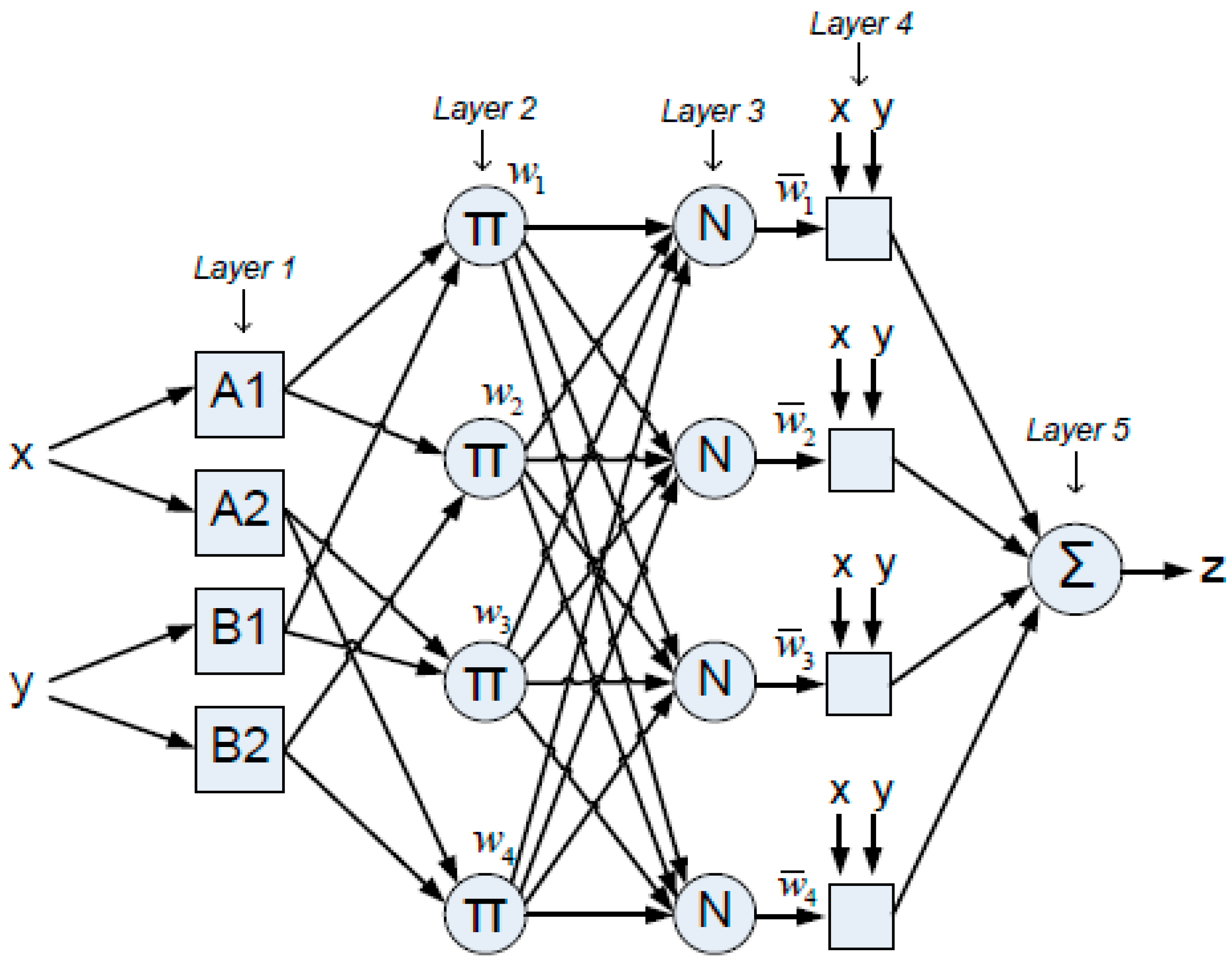

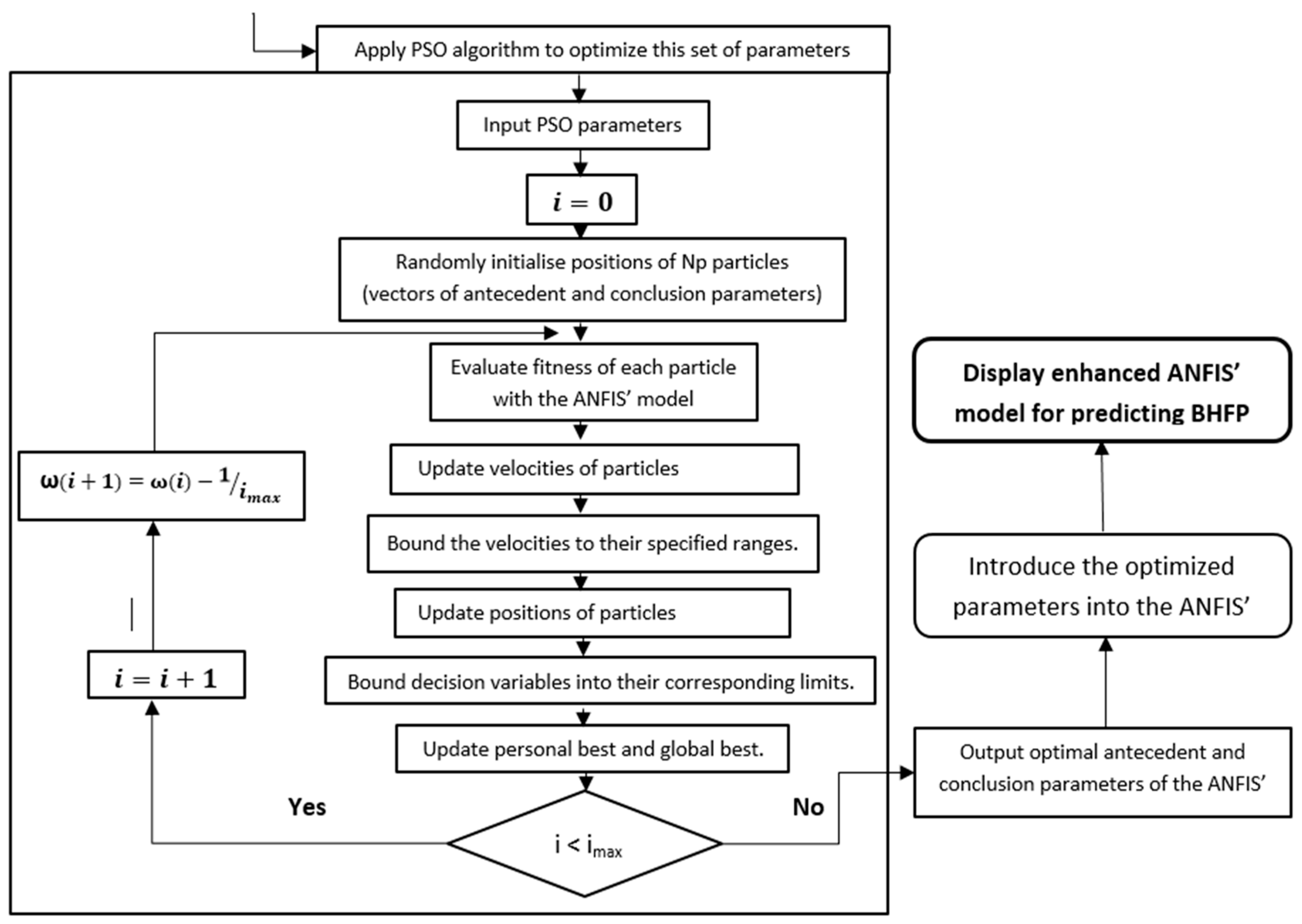
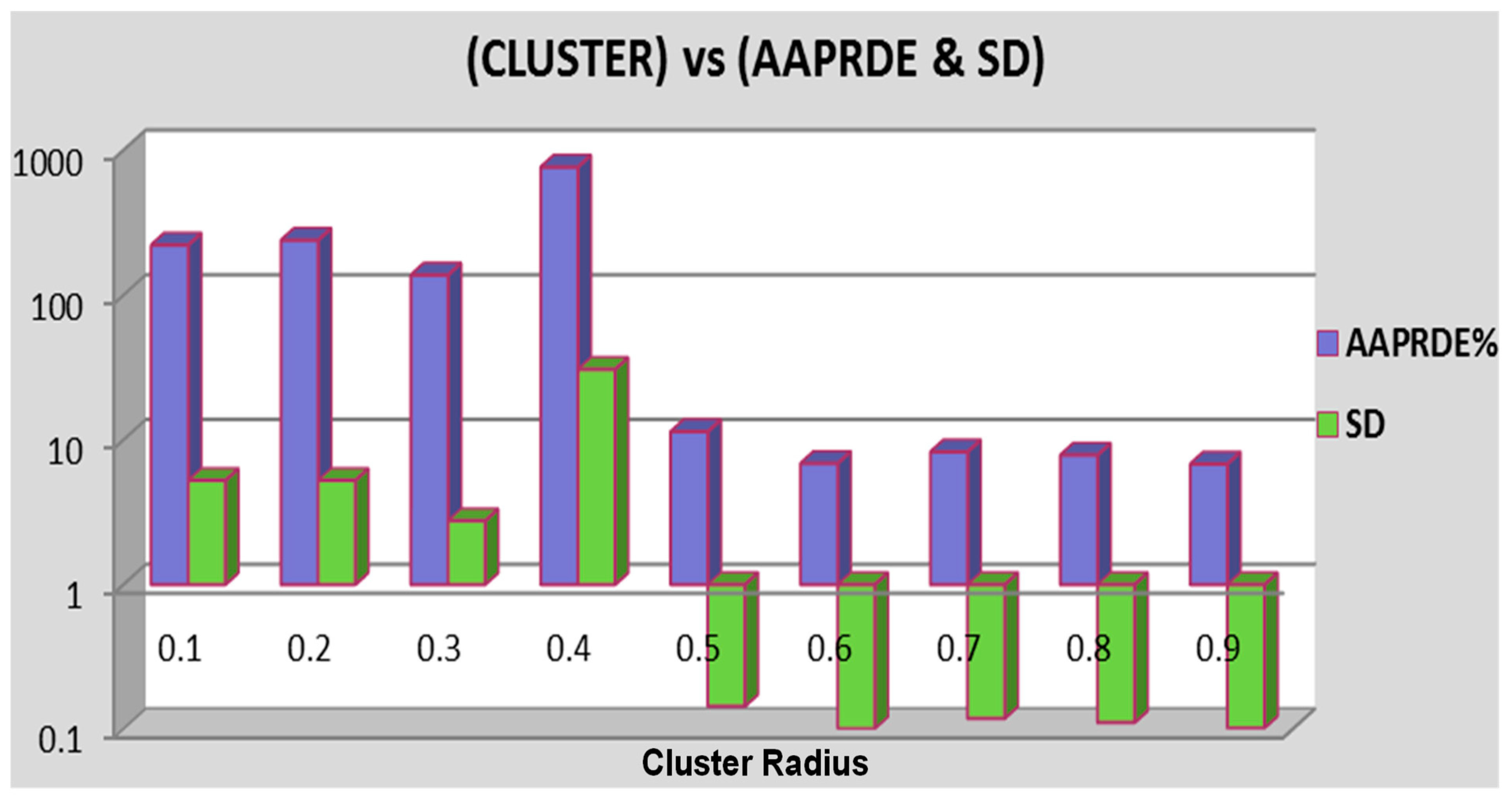
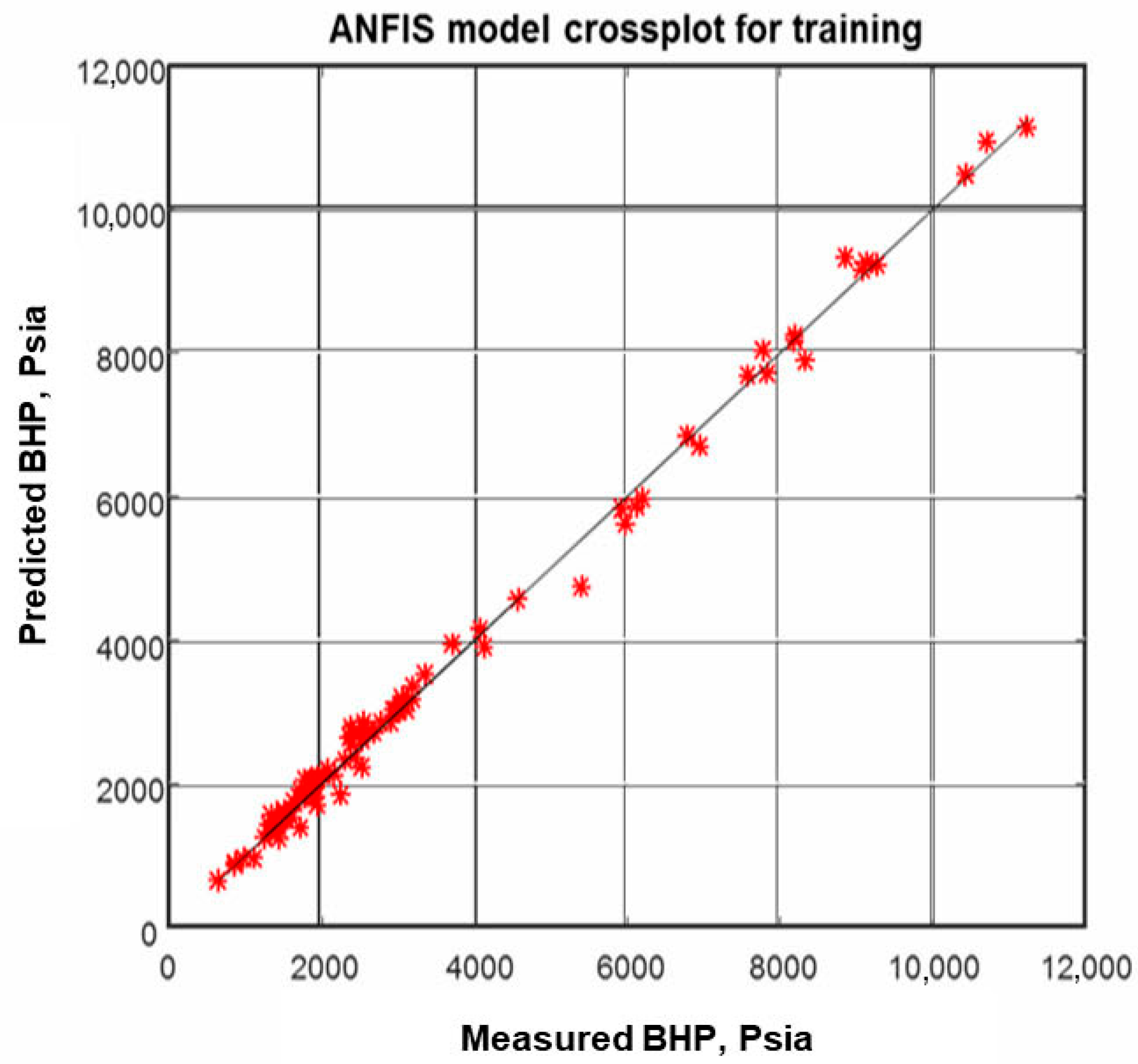
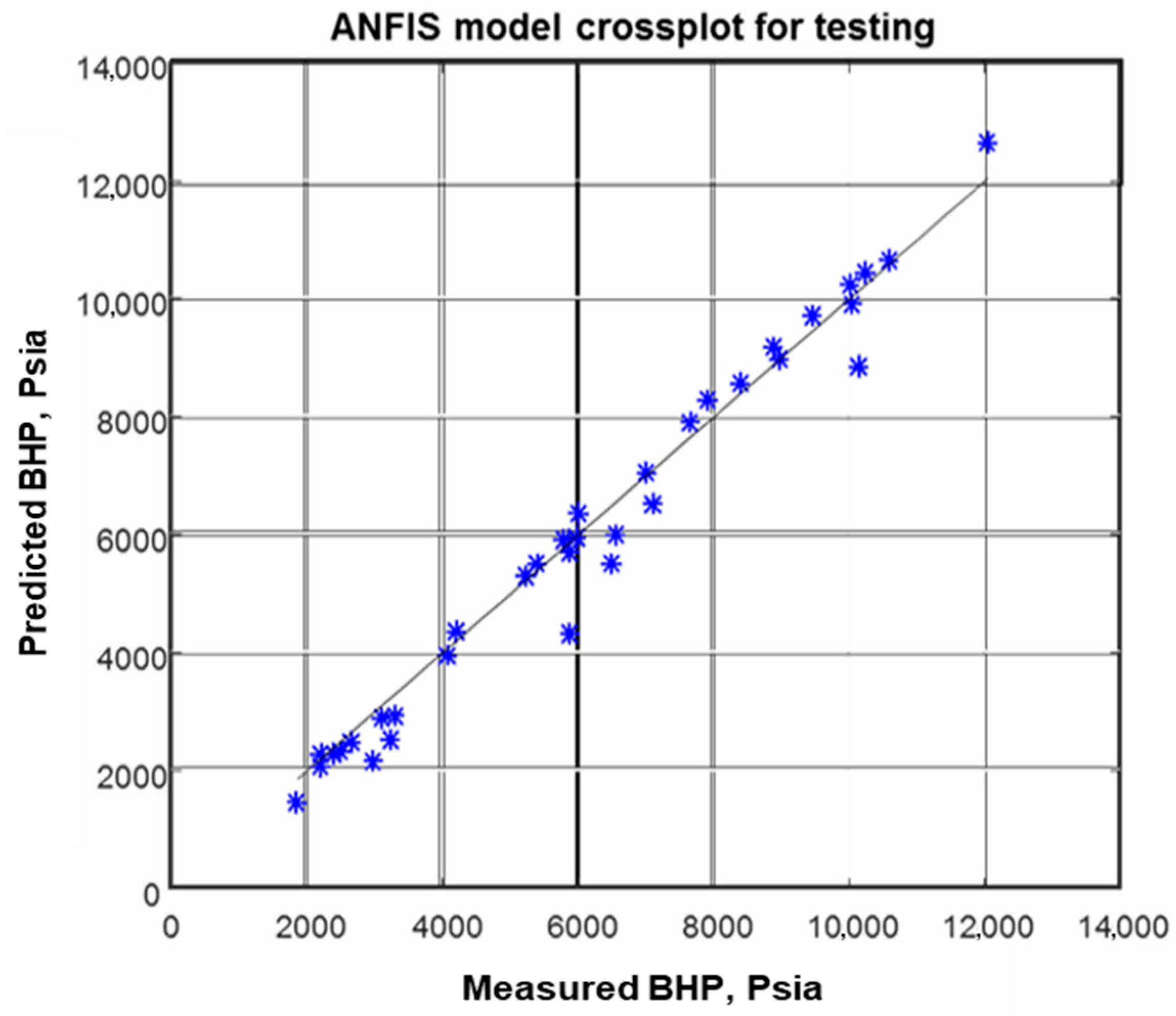
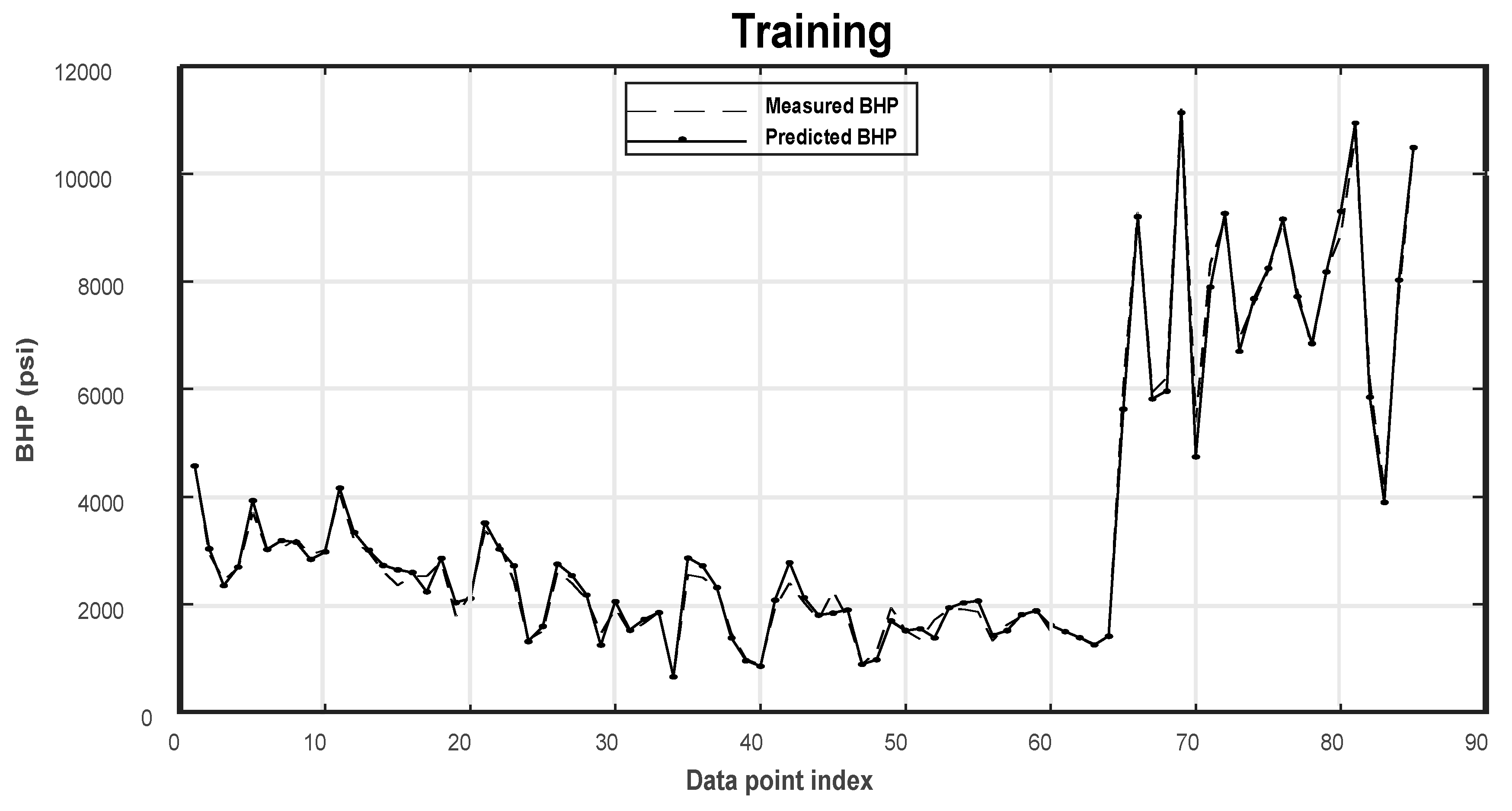

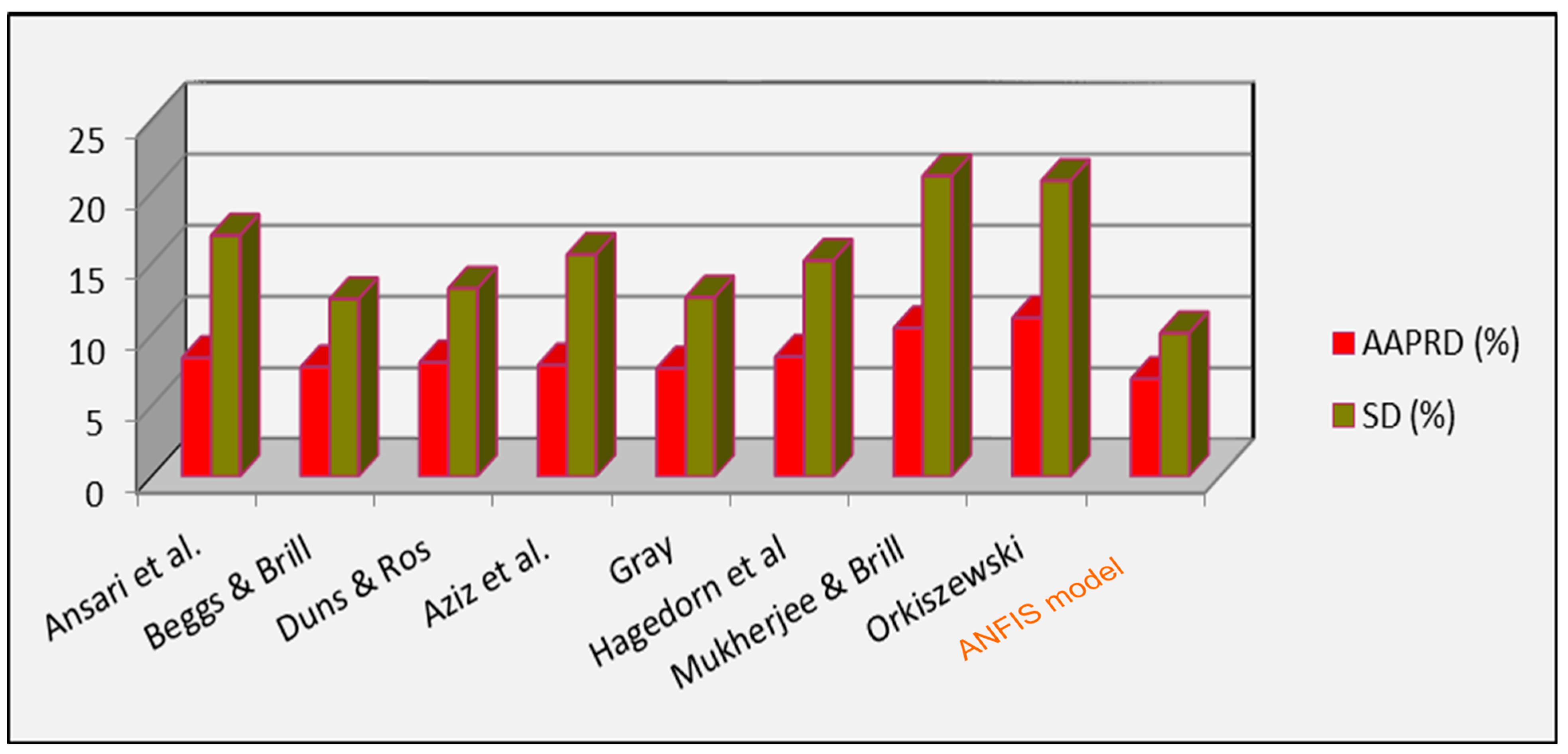
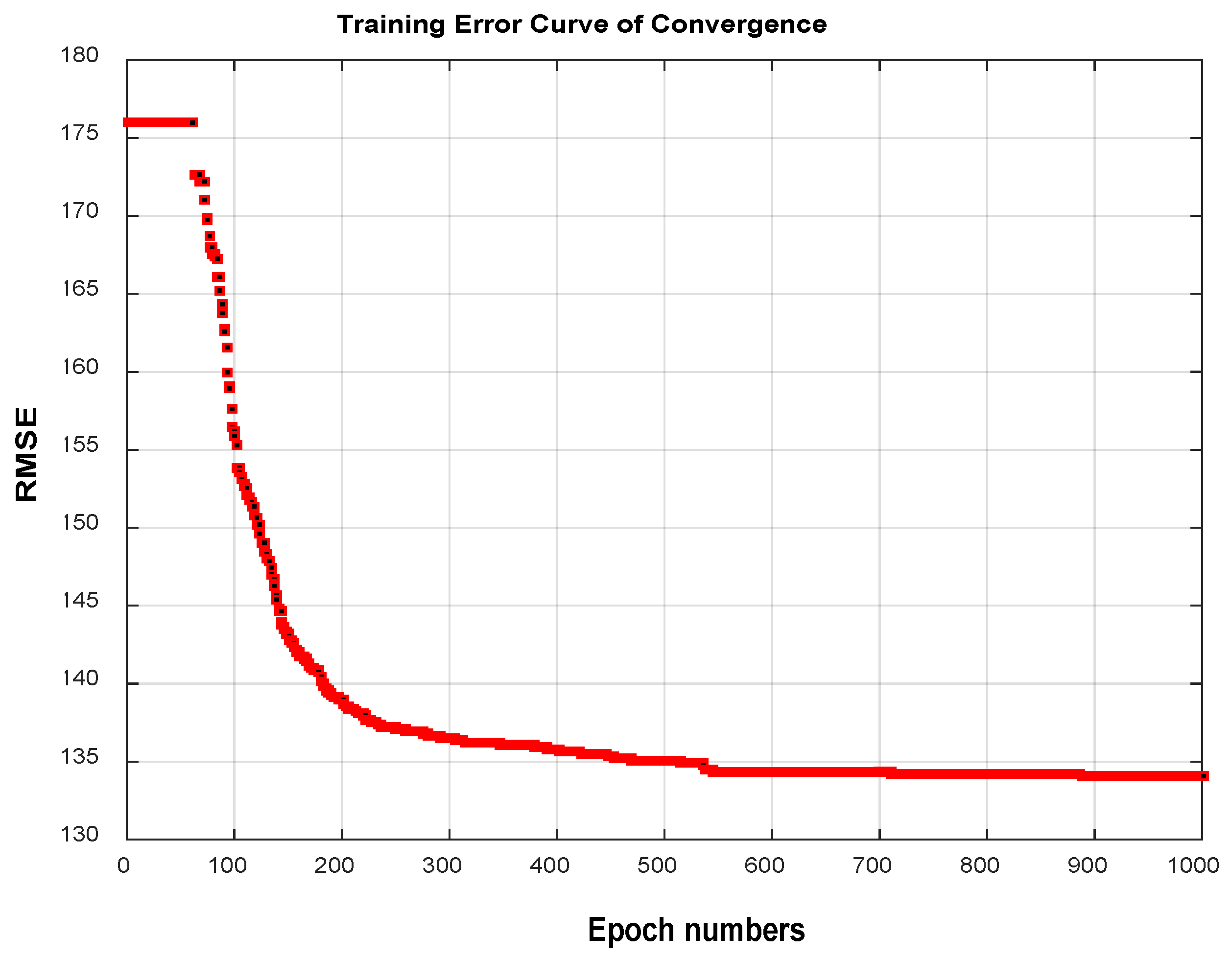
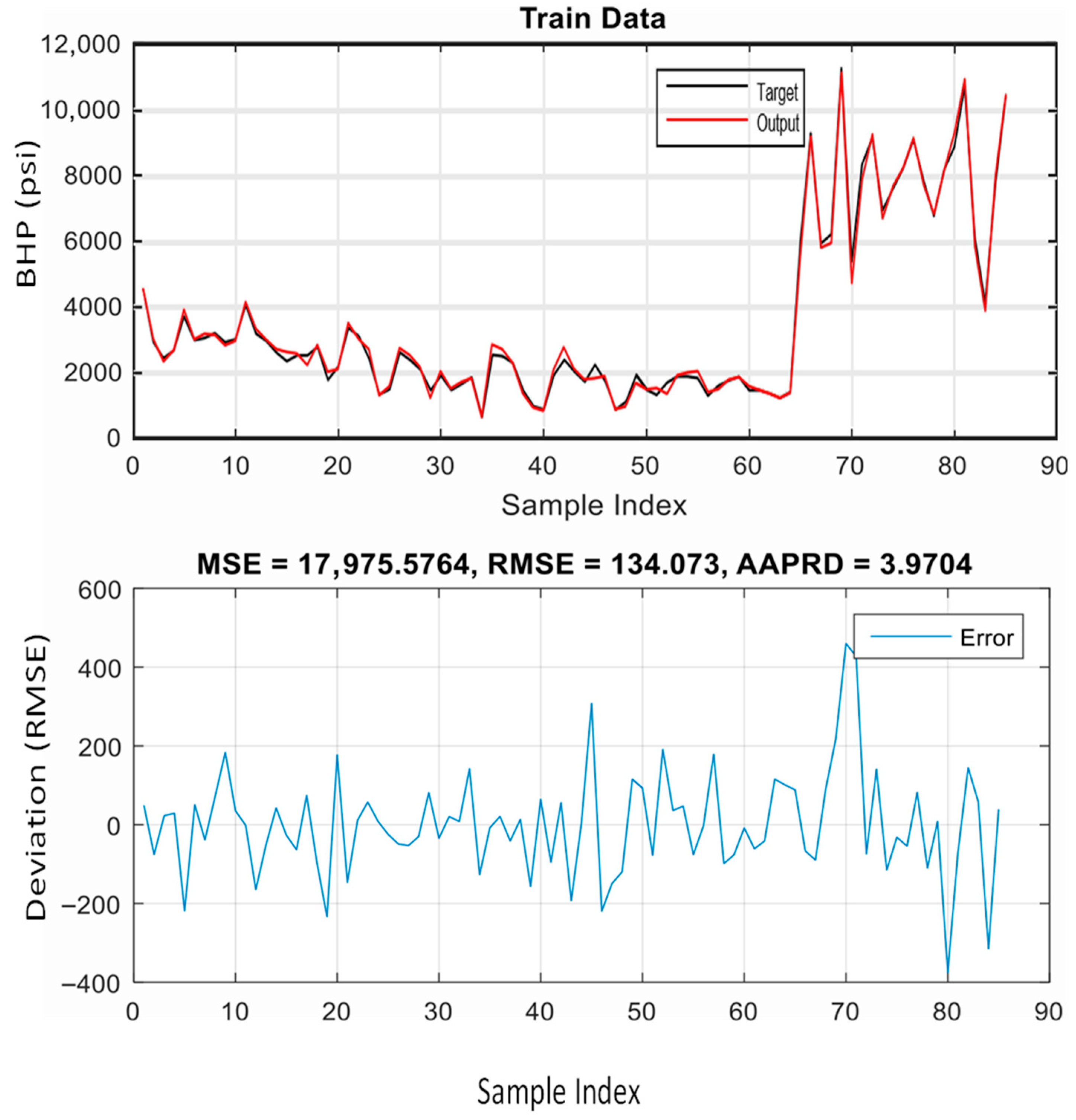
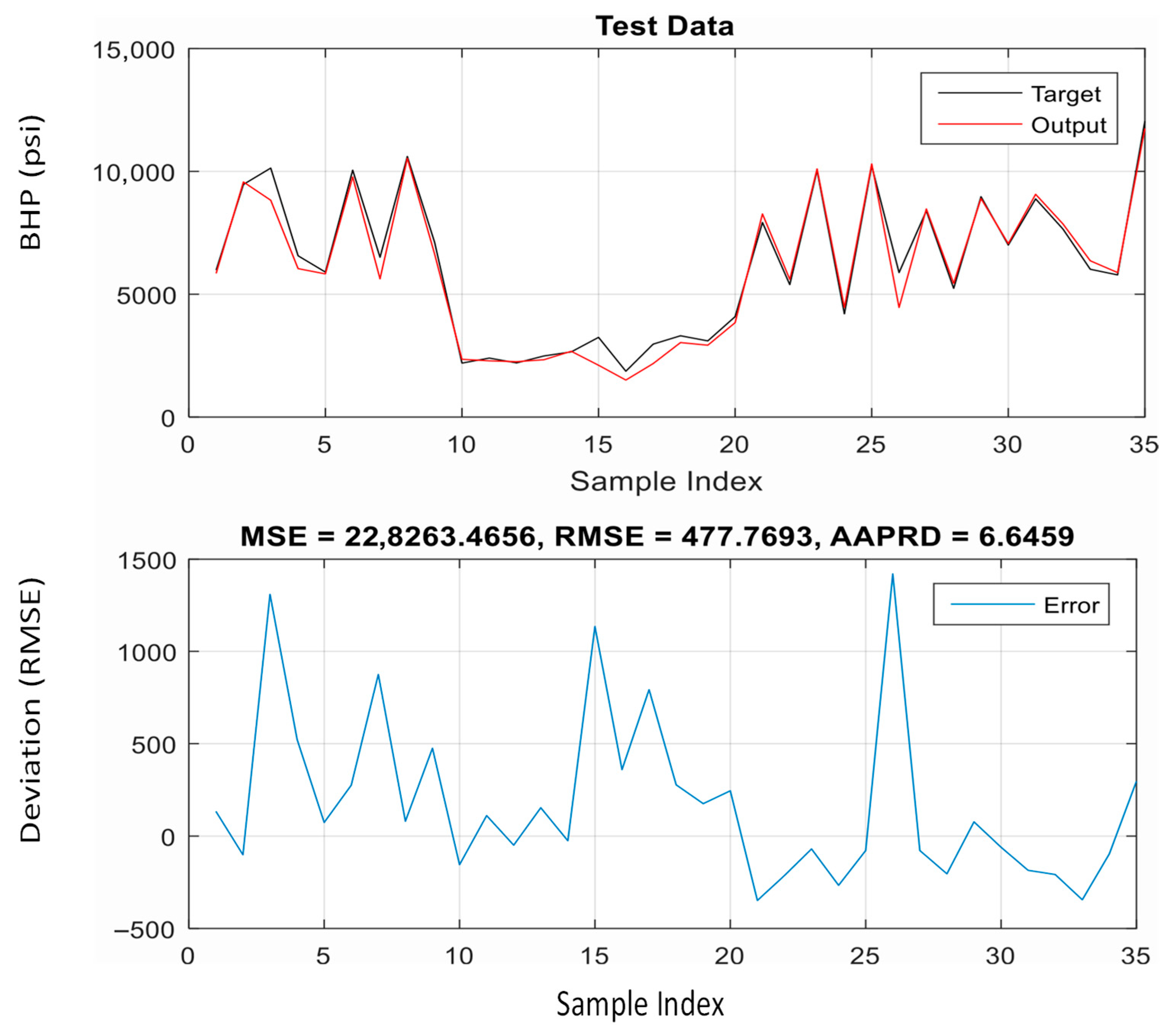
| Parameter | Property | MIN | MAX | AVG |
|---|---|---|---|---|
| Input | Oil rate, (bbl/d) | 11 | 1300 | 655.5 |
| Gas rate, (Mscf/d) | 572 | 22,500 | 11,536 | |
| Water rate (bbl/d) | 0 | 750 | 375 | |
| Oil gravity | 0.569 | 0.931 | 0.75 | |
| Gas gravity | 0.627 | 0.884 | 0.755 | |
| Tubing diam, (in) | 1.61 | 4.404 | 3.007 | |
| Depth, (ft) | 3678 | 14,742 | 9210 | |
| Wellhead P, (psi) | 450 | 8472 | 4461 | |
| Wellhead T, (°F) | 46 | 184 | 115 | |
| GOR, (scf l/stb) | 5.180 | 1160 | 587.6 | |
| Output | BHP, (psi) | 653 | 11,250 | 5951 |
| Training | Test | |||||||
|---|---|---|---|---|---|---|---|---|
| Cluster Radius | R2 | AAPRDE% | AADE | SD | R2 | AAPRDE % | AADE | SD |
| 0.1 | 0.3472 | 78.7653265 | 1948.66113 | 2.74151548 | 0.3863 | 221.687333 | 15,990.9273 | 5.23971701 |
| 0.2 | −0.0246 | 561.132929 | 9895.54936 | 15.8304181 | 0.3638 | 239.115256 | 15,364.3451 | 5.24253765 |
| 0.3 | 0.0480 | 392.953395 | 11,731.375 | 32.4654481 | 0.5204 | 137.458815 | 10,849.3372 | 2.75916563 |
| 0.4 | 0.0358 | 707.041957 | 21,352.5187 | 64.8106879 | −0.2979 | 765.94173 | 63,651.1889 | 30.6617052 |
| 0.5 | 0.9969 | 5.97373598 | 153.3456 | 0.08601994 | 0.9676 | 11.4093001 | 630.184881 | 0.14421671 |
| 0.6 | 0.9973 | 6.22486968 | 149.203488 | 0.09356063 | 0.9893 | 6.86735781 | 337.489552 | 0.10069916 |
| 0.7 | 0.9968 | 7.05710307 | 170.351771 | 0.10695599 | 0.9852 | 8.25825025 | 413.196151 | 0.11899872 |
| 0.8 | 0.9986 | 4.05751626 | 102.256198 | 0.05839112 | 0.9855 | 7.84876421 | 402.845595 | 0.11145306 |
| 0.9 | 0.997 | 4.96684981 | 137.390454 | 0.06839884 | 0.9887 | 6.80692557 | 336.3169 | 0.10190839 |
| MODEL | R2 | AAPRD (%) | SD (%) |
|---|---|---|---|
| Ansari et al [22] | 0.966 | 8.3309 | 16.931 |
| Beggs and Brill [19] | 0.976 | 7.6894 | 12.463 |
| Duns and Ros [17] | 0.973 | 8.0225 | 13.208 |
| Aziz et al [20] | 0.968 | 7.822 | 15.584 |
| Gray [23] | 0.972 | 7.5973 | 12.574 |
| Hagedorn and Brown [16] | 0.967 | 8.4236 | 15.157 |
| Mukherjee and Brill [21] | 0.9520 | 10.427 | 21.108 |
| Orkiszewski [18] | 0.937 | 11.152 | 20.761 |
| The ANFIS model | 0.988 | 6.80693 | 10.191 |
| Training | Test | |||
|---|---|---|---|---|
| AAPRD (%) | RMSE | AAPRD (%) | RMSE | |
| ANFIS (BP-LS) | 4.9668 | 184.62 | 6.8069 | 489.806 |
| ANFIS (PSO) | 3.9703 | 134.073 | 6.6459 | 477.7693 |
Disclaimer/Publisher’s Note: The statements, opinions and data contained in all publications are solely those of the individual author(s) and contributor(s) and not of MDPI and/or the editor(s). MDPI and/or the editor(s) disclaim responsibility for any injury to people or property resulting from any ideas, methods, instructions or products referred to in the content. |
© 2025 by the authors. Licensee MDPI, Basel, Switzerland. This article is an open access article distributed under the terms and conditions of the Creative Commons Attribution (CC BY) license (https://creativecommons.org/licenses/by/4.0/).
Share and Cite
Redouane, K.; Jahanbani Ghahfarokhi, A. A New Hybrid Intelligent System for Predicting Bottom-Hole Pressure in Vertical Oil Wells: A Case Study. Algorithms 2025, 18, 549. https://doi.org/10.3390/a18090549
Redouane K, Jahanbani Ghahfarokhi A. A New Hybrid Intelligent System for Predicting Bottom-Hole Pressure in Vertical Oil Wells: A Case Study. Algorithms. 2025; 18(9):549. https://doi.org/10.3390/a18090549
Chicago/Turabian StyleRedouane, Kheireddine, and Ashkan Jahanbani Ghahfarokhi. 2025. "A New Hybrid Intelligent System for Predicting Bottom-Hole Pressure in Vertical Oil Wells: A Case Study" Algorithms 18, no. 9: 549. https://doi.org/10.3390/a18090549
APA StyleRedouane, K., & Jahanbani Ghahfarokhi, A. (2025). A New Hybrid Intelligent System for Predicting Bottom-Hole Pressure in Vertical Oil Wells: A Case Study. Algorithms, 18(9), 549. https://doi.org/10.3390/a18090549







